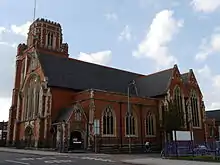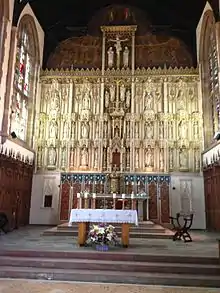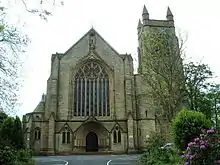Edward Goldie
Edward Goldie (1856–1921) was an English ecclesiastical architect who was notable for building Roman Catholic churches mainly in the form of Gothic Revival architecture. He was the son of George Goldie.[1]
Life
He was born in Sheffield in 1856. His father was George Goldie. He went to school at Ushaw College in County Durham, as his father had previously done. In 1875, he was articled to Goldie & Child.[2] It was an architectural firm which his father ran with Charles Edwin Child. After his apprenticeship ended in 1880, he remained at the firm as a partner,[1] so it became Goldie, Child & Goldie.[3] From 1893, Edward ran the firm on his own. In 1913, he was joined by his son, Joseph Goldie, and the firm became Edward Goldie & Son until 1953.[4]
Joseph Goldie
Edward Goldie's son, Joseph Goldie (1882–1953), followed in the steps of his father and grandfather and became an ecclesiastical architect designing churches for the Roman Catholic church. Joseph Goldie, with his father, were the architects for St John the Evangelist Church in Horsham.[5] After his father's death, he designed Church of Our Lady and St Peter in Leatherhead in 1923, St Thomas More Catholic Church in Dulwich in 1928, St Patrick's Church in Cardiff in 1929, Church of the Assumption of Our Lady in Englefield Green in 1930 and St Dunstan's Church in Woking, which was demolished in 2008.[6]
Works
His works include:
- St Alban's Church, Larkhill, Lancashire, built from 1900 to 1901.[2]
- St Cecilia's Abbey, Ryde, Isle of Wight, completed in 1907.
- St George's Retreat, Burgess Hill, built from 1905 to 1906.[4]
- The Lees, 1 Manor Road, Brighton, built in 1906 for St George's Retreat's Reverent Superioress.[7]
- St James's, Spanish Place, London, completed in 1890.
- St John the Evangelist Church, Horsham, West Sussex, built from 1919 until 1923.[4]
- St Paul the Apostle, Wood Green, London; 1904, replaced 1971.[8]
- St Peter and St Paul Church, Wolverhampton, extension built in 1901.
- St Thomas a Becket, Wandsworth, London, completed in 1895.
- Ashorne Hill House, Newbold Pacey, Warwickshire, built from 1895 to 1897.[2]
- Hawkesyard Priory, Staffordshire, built from 1896 to 1914.
- Our Lady of England Priory, Storrington, West Sussex, built from 1904 to 1905.[2]
- Our Most Holy Redeemer and St Thomas More, Chelsea, London, built from 1894 to 1895.
Gallery
 St James' Church, Spanish Place
St James' Church, Spanish Place Church of Our Most Holy Redeemer and St Thomas More, Chelsea.
Church of Our Most Holy Redeemer and St Thomas More, Chelsea. St Thomas a Becket, Wandsworth
St Thomas a Becket, Wandsworth Hawkesyard Priory interior
Hawkesyard Priory interior St Alban's Church, Larkhill, Blackburn
St Alban's Church, Larkhill, Blackburn Our Lady of England Priory, Storrington
Our Lady of England Priory, Storrington St Cecilia's Abbey, Ryde
St Cecilia's Abbey, Ryde_(1).JPG.webp) The Lees, Manor Road, Brighton
The Lees, Manor Road, Brighton
References
- Edward Goldie from Dictionary of Scottish Architects, retrieved 6 February 2015
- Gray, A. S. "Goldie, Edward", in A Dictionary of Architecture and Landscape Architecture (Oxford University Press, 2006) p. 322.
- The Late Mr George Goldie from The Tablet, 19 March 1887, retrieved 7 February 2015
- "Horsham - St John the Evangelist". English Heritage. Retrieved 19 February 2015.
- English Heritage Review of Diocesan Churches 2005 from Diocese of Arundel and Brighton, retrieved 29 April 2013
- Englefield Green - The Assumption of Our Lady from English Heritage, retrieved 19 February 2015
- "Local List of Heritage Assets: M" (PDF). Brighton and Hove City Council. 2014. Archived (PDF) from the original on 4 April 2016. Retrieved 4 April 2016.
- Taking Stock, online resource accessed 10 October 2017